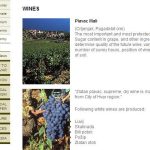As a Master of Wine picks her first grapes on the island, the Hvar Wine Assocation prepares to present its wines in Rome.
The Hvar wine story is going from strength to strength. As I reported for Google News last night, Master of Wine Jo Ahearne (one of only 314 in the world) has settled into her new life in Jelsa, picking her first grapes with Andro Tomic yesterday. A Master of Wine making her own wine in Jelsa – a great wine story for the island’s winemakers.
They too have been busy, collecting the harvest in vineyards all over the Hvar, but with an eye on Rome, for along with other regions in Croatia, the Hvar Wine Association will have their wines presented on October 6 in the Italian capital.
With the quality and reputation of its local wines, Italy will be a tough market to crack, but Hvar Wine Association President Ivana Krstulovic Caric has been steadily building her contacts, and indeed Vina Caric even shipped their first consignment to Italy this year.
Rome presents an opportunity to showcase some of the very best of Hvar’s wines, with Caric, Vujnovic, Tomic, Zlatan Otok and PZ Svirce all represented. It is all happening at Banchi d’assaggio dalle 16 alle 21,30 presso l’Hotel Rome Cavalieri – via A. Cadlolo, 101. More information in Italian below, or click on the link to the official site here.
Se si guarda all’Est europeo, sono molti i Paesi di lunghe e nobili tradizioni vitivinicole, che si stanno gradualmente affacciando, con grande entusiasmo, alla produzione di vini di qualità, anche grazie all’afflusso di investimenti stranieri. Sono terre da scoprire ad apprezzare, che a volte regalano grandi soddisfazioni con vini prodotti da vitigni autoctoni o internazionali, a prezzi (ancora) assolutamente abbordabili. La Croazia è una di queste. La sua viticoltura è caratterizzata dalla presenza di numerosi vitigni autoctoni, uno dei quali, il Crljenak Kaštelanski, ha ottenuto grande fortuna altrove con i “sinonimi” (si tratta in realtà di cloni diversi) di Primitivo e Zinfandel.
La regione più rinomata è la Dalmazia, per la molteplicità dei suoli e delle caratteristiche dei vitigni, il più noto dei quali è oggi il Plavac Mali, varietà anch’essa parente del Primitivo, che sulla penisola di Peljesac dà vini potenti, fruttati e di notevole tenore alcolico, in via di affermazione anche sui mercati internazionali. Ottimo anche il Babi?, coltivato specialmente attorno a Primosten, le cui uve danno vini meno colorati rispetto al Plavac Mali, ma più eleganti. Tra i vitigni a bacca bianca, i più conosciuti sono invece il Pošip, la Marastina (della famiglia delle Malvasie) e il Debit (il nostro Pagadebit). Nell’Istria, è ovviamente diffusa la Malvasia Istriana, mentre all’interno, nella Slavonia, si coltivano principalmente le varietà tipiche di Austria e Ungheria. Conosceremo i vini della terra croata in un grande banco d’assaggio dedicato a ciascuna delle sue regioni, Istria, Dalmazia, Zagorje e Slavonia.











